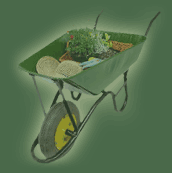PLANT CARE
WATERING
 We thoroughly water plants after installation, after which it becomes the owner’s responsibility. It is very difficult to tell an owner how and when to water plants because not all landscape situations are the same. The best we can do is give general guidelines to follow. One important note to remember is plants can die from over watering just as easy as under watering.
We thoroughly water plants after installation, after which it becomes the owner’s responsibility. It is very difficult to tell an owner how and when to water plants because not all landscape situations are the same. The best we can do is give general guidelines to follow. One important note to remember is plants can die from over watering just as easy as under watering.
 Check you plants each week. The best way to tell if your plants need water is to feel the soil 4" deep and water only if dry. Generally when plants are just planted they will need to be watered thoroughly for the first week. Sprinkling shrubs and watering trees with a slow trickle for 10-20 minutes is a good practice. Again test the soil or watch plants to determine when watering is needed. Too much water can be detected in some plants by yellowing of the leaves. The first growing season is the most important for watering. If your plants have settled in successfully you should not have to worry about watering them very much unless there is a particular dry spell. If you have a in ground sprinkler system, remember your plants do not need as much water as you lawn. Monitor the sprinklers to make sure you plants are not getting too much water.
Check you plants each week. The best way to tell if your plants need water is to feel the soil 4" deep and water only if dry. Generally when plants are just planted they will need to be watered thoroughly for the first week. Sprinkling shrubs and watering trees with a slow trickle for 10-20 minutes is a good practice. Again test the soil or watch plants to determine when watering is needed. Too much water can be detected in some plants by yellowing of the leaves. The first growing season is the most important for watering. If your plants have settled in successfully you should not have to worry about watering them very much unless there is a particular dry spell. If you have a in ground sprinkler system, remember your plants do not need as much water as you lawn. Monitor the sprinklers to make sure you plants are not getting too much water.
Fertilizing
A good fertility program will promote healthy pants in any landscape. Trees and shrubs can be fertilized in the spring (March through April) and in the fall (October through November). A pellet form of slow release fertilizer will be fine for most plants. Put the recommended dose at the base of trees and shrubs without touching the leaves. If the fertilizer gets on the leaves rinse thoroughly. Certain plants will do better under acidic conditions, in which case you would want to use a more acid based fertilizer. These plants include but are not limited to azaleas, rhododendrons, hydrangea, and dogwood.
Weeds
 Weeds compete with landscape shrubs and trees for light, nutrients , and water. They can also promote insect and disease problems. Weeds can be controlled by mulching regularly, hand removal, and apply pre-emergent and/or herbicides. Applying Preen to your landscape beds in spring will save you a lot of time weeding.
Weeds compete with landscape shrubs and trees for light, nutrients , and water. They can also promote insect and disease problems. Weeds can be controlled by mulching regularly, hand removal, and apply pre-emergent and/or herbicides. Applying Preen to your landscape beds in spring will save you a lot of time weeding.
Trimming
 Pruning is one of the most important landscape practices. When done properly it maintains the shape of the plant and promotes healthy growing conditions.
Pruning is one of the most important landscape practices. When done properly it maintains the shape of the plant and promotes healthy growing conditions.
 Evergreen shrubs can be trimmed year round but avoid particularly cold or hot spells. Flowering shrubs should be trimmed after they flower. Grasses and Roses should be cut back in late February or early March. Perennials can be topped off after flowering back to new foliage growth at the base of the plants and again in the fall when they turn brown. Late spring is a good time to trim because most of your new growth will have occurred.
Evergreen shrubs can be trimmed year round but avoid particularly cold or hot spells. Flowering shrubs should be trimmed after they flower. Grasses and Roses should be cut back in late February or early March. Perennials can be topped off after flowering back to new foliage growth at the base of the plants and again in the fall when they turn brown. Late spring is a good time to trim because most of your new growth will have occurred.

